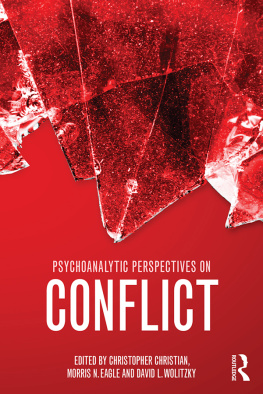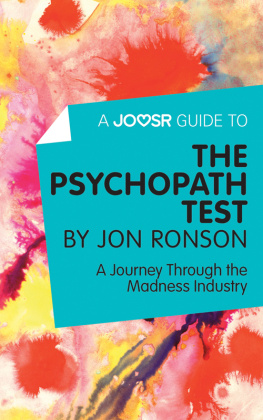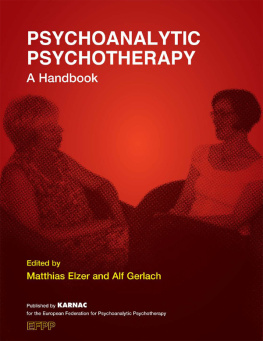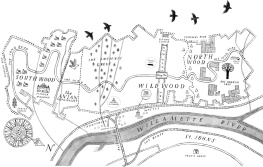
THE MARK OF CAIN
Psychoanalytic Insight and the Psychopath
EDITED BY
J. Reid Meloy
The Mark of Cain makes available for the first time the accumulated psychoanalytic understanding of the psychopathic mind. Editor J. Reid Meloy, a leading authority on the psychology of the psychopath, has brought together in a single collection the most historically important psychoanalytic papers on the psychopath papers by Helene Deutsch, Wilhelm Reich, John Bowlby, Phyllis Greenacre, August Aichhorn, Adelaide Johnson, Donald Winnicott, Betty Joseph, Neville Symington, Ben Bursten, and Otto Kernberg, among others and delineated their continuing relevance to contemporary understanding.
According to Meloy, two theoretical traditions flow into the psychoanalytic understanding of psychopathy. The first tributary focuses on the early development of the psychopath in order to illuminate how a profound alteration in self-regard leads both to a denigration of the other and to an impulsive search for gratification in the present. The second tributary seeks to locate the psychopathic miscarriage of human potentiality within analytic theories of personality structure and clinically grounded differential diagnosis. The Mark of Cain presents the major contributions associated with both of these traditions. included within this body of literature are the original formulations of concepts that have long since become part of the psychoanalytic nomenclature: the affectionless juvenile offender, the diagnostic significance of affect hunger, the behavioral consequences of superego lacunae, the recourse to promiscuous identification in the impostor, and the paradoxically lethal lure of malignant narcissism.
Of special note are Meloys historical notes to each chapter and two section introductions, the latter major essays in their own right. in the spirit of integration that typifies his approach to psychopathy, Meloy shows how a profoundly disordered attachment history and the early appearance of a severe conduct disorder, two psychodiagnostic indicators of psychopathy, can be reconfigured in the context of current biological and sociological research. Equally conversant with the treatment issues specific to this difficult patient population, he illuminates how the distinctive countertransference responses elicited by the psychopath may assist the clinician in avoiding victimization.
The explosion of empirical research on psychopathy over the past two decades masks the fact that much contemporary work in this area is grounded in the clinical formulations of leading psychoanalysts of the twentieth century. The Mark of Cain rescues this intimate understanding of the inner world of the psychopath and thereby contributes to clinical realism in the face of deception, manipulation, exploitation, and even frank dangerousness.

PHOTO: 1997 ANNIE LEMOUX
J. Reid Meloy, Ph.D. is associate clinical professor of psychiatry at the University of California, San Diego, School of Medicine and adjunct professor at the University of San Diego School of Law. A past president of the American Academy of Forensic Psychology, he is the author of numerous books and articles on psychopathy. He currently devotes his time to a private civil and criminal forensic practice and to research, writing, and teaching in this area.
The Mark of Cain
The Mark of Cain
Psychoanalytic Insight and the Psychopath
Edited by J. Reid Meloy

2001 by The Analytic Press
All rights reserved. No part of this book may be stored, transmitted, or reproduced in any form whatsoever without the prior written permission of the publisher.
Published by
The Analytic Press, Inc., Publishers
Editorial Offices:
101 West Street
Hillsdale, New Jersey 07642
www.analyticpress.com
Set in Palatino 10.5 / 12 by
Christopher Jaworski, Qualitext
Index by Leonard S. Rosenbaum
Library of Congress Cataloging-in-Publication Data
Reid Meloy, J., 1949
The mark of Cain : psychoanalytic insight and the psychopath / edited by J. Reid Meloy.
p. cm.
Includes bibliographical references and index
ISBN 0-88163-310-0
1. Antisocial personality disorders. 2. Psychopaths.
I. Meloy, J. Reid.
RC555.M37 2001
616.8582dc21
200122679
Printed in the United States of America
10 9 8 7 6 5 4 3 2
This book is dedicated to the students and faculty of the John Jay College of Criminal Justice
Cain said to his brother Abel, Let us go into the open country.
While they were there, Cain attacked his brother Abel and murdered him.
The Lord said, What have you done? Hark! Your brothers blood that has been shed is crying out to me from the ground You shall be a vagrant and a wanderer on earth.
So the Lord put a mark on Cain, in order that anyone meeting Him should not kill him. Then Cain went out from the Lords presence
Genesis 4:816
Two traits are essential in the criminal: boundless egoism and a strong destructive impulse. Common to both of these, and a necessary condition for their expression, is the absence of love, the lack of an emotional valuation of (human) objects.
Sigmund Freud, Dostoevsky and Parricide
CONTENTS
Preface
J. Reid Meloy, Editor
W hen I was a young man, a newly licensed psychologist in the State of California, Kathy Wachter-Poynor, the local public mental health director, offered me a position that was to change my life and my career. She asked if I would consider developing an acute psychiatric inpatient program for mentally ill offenders in a maximum security setting. My excitement, composed equally of a tremendous naivete and a fierce ambition, both now tempered by years of experience, carried me into this valley of the shadow of death. Thankfully, I did come to fear evil.
I fairly quickly arrived at the realization that little was clinically known about some of the men I began to encounter. In those days of the ancien rgimeDSM III had just been publishedthe application of specific criteria to arrive at a reliable, descriptive diagnosis was the coin of the realm. Little thought was given to the notion of psychopathy; no contemporary psychoanalytic writers used the term (although a few still clung to the anachronistic word sociopathy); and the word psychopath was central only to the empirically rigorous, and nonanalytic, psychological research of Robert Hare and his students at the University of British Columbia, unheralded at that time.
Unable to shake my undergraduate major in history at the College of Wooster, I began to peruse the older psychoanalytic literature for hints of clinical wisdom concerning the psychopath. I began also to search for contemporary psychoanalytic theorists who were at least obliquely interested in the internal life of such untreatable persons. I found a vein of data: gems from the past and a few diamonds from the present.
This book crystallized in my mind about six years ago, when I realized that my private intellectual labor of love might be of use to others; it could possibly become a published anthology of psychoanalysts approaches to various facets of the psychopath, a book informed and balanced by what is currently known about psychopathy from a social, psychological, and biological research perspective.
Next page












